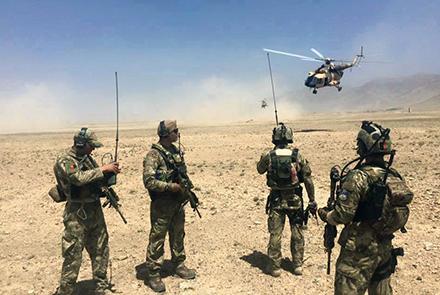Casualties among Afghan National Army Soldiers have risen sharply this month, compared to last month, said Major Gen. Abdul Raziq Siawash, the Commander of the Afghan National Army (ANA) Health Department.
Although, Siawash did not provide an exact figure about the overall number of deaths of soldiers, he said the increase in casualties comes despite the ongoing efforts to reach a peace agreement.
Deputy minister of defense, Iaqbal Ali meanwhile paid tribute to all the hardworking military medical staff.
He said: “We appreciate our doctors and surgeons for working day and night to treat our wounded officers,” said deputy minister of defense Iaqbal Ali.
“The opposing side (insurgents) hide in trees and gardens and this is one of the reasons which is causing casualties for us,” said Siawash.
“The wounded officers who sustain injuries in the trenches or while on duty should be transferred to hospital as soon as possible,” said Amruddin, a wounded ANA officer.
This comes as Afghan security forces tackle Taliban insurgents on multiple fronts across the country.
Last week The Afghan Ministry of Interior (MoI) confirmed there has been a sharp rise in casualties among security forces in the past few weeks after Taliban insurgents expanded their attacks on multiple fronts.
Taliban insurgents recently sought to expand their attacks in some strategic locations of Baghlan, Kunduz, Faryab, Uruzgan, Ghor and Farah provinces.
Highlights of civilian and military casualty toll over past few months
In September, Senators in the Meshrano Jirga (Upper House of Parliament) summoned Ministers of Defense and Interior and the deputy head of the National Directorate of Security (NDS) to answer questions over the increase of insecurity in the country and the high casualty toll among security forces.
Afghan Defense Minister Gen. Tariq Shah Bahrami at the time acknowledged there was an increase in casualties among Afghan National Army (ANA) soldiers and said in the past month 513 soldiers had been killed.
Civilians also the target
Last month, the United Nations Assistance Mission in Afghanistan (UNAMA) released a special report and voiced serious concerns about the increasing use of IEDs against civilians.
In a statement issued with the report, UNAMA said anti-government elements must immediately end the indiscriminate and disproportionate use of all improvised explosive devices (IEDs) in areas frequented by civilians.
Between 1 January and 30 September 2018, UNAMA documented 3,634 civilian casualties (1,065 deaths and 2,569 injured) from suicide and non-suicide IED attacks.
These casualty figures include 247 women casualties (72 deaths and 175 injured) and 608 child casualties (155 deaths and 453 injured).
During the period covered by this report, suicide IED attacks killed and injured increasing numbers of women and children, mainly due to a rise in the deliberate targeting of civilian objects where women and children were present.
Between 1 January and 30 September 2018, civilian casualties from attacks with all types of IEDs increased by 21 percent compared with the same period in 2017, while the number of civilian casualties from suicide IED attacks increased by 46 percent.
The use of suicide IEDs alone caused more civilian deaths and injuries than any other tactic, including ground engagements.
Between 1 January and 30 September 2018, UNAMA documented 1,402 civilian casualties (433 deaths and 969 injured) in Kabul city, with 99 percent of these caused by suicide and other IED attacks. So far in 2018, the mission has documented 34 IED incidents causing civilian casualties in Kabul province (23 suicide IED attacks and 11 non-suicide IED attacks).
However, the casualty toll among security forces is classified information after a decision was taken in 2016 not to release exact figures.



Comment this post